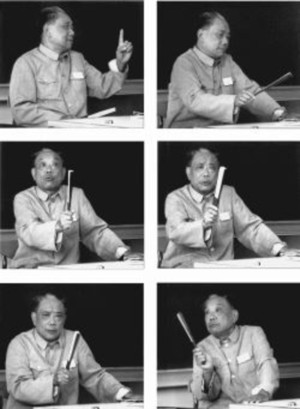Elements of Performance (11)

Telling the tale
Before entering the stage for the daily performance, the storyteller usually prepares himself in silent meditation in his changing room, called to "warm up the story" wushu. He ponders the string of episodes, the "road of the story" shuluzi, to be told that day.
Since storytelling is traditionally performed in installments that are continued over several months of daily performances, we have different expressions for how to begin a new story cycle, called "open up a story" kaishu, and how to begin the day's episode, called "open the mouth" kaikou. The simplest and the most common way is to start directly from the point where the story was interrupted the previous day, or begin with a short repetition of the final episode. If the method for "opening the mouth" implies the use of extraneous material, that does not belong to the story cycle as such, this is called a "story head" shutouzi, e.g. cracking a couple of jokes or reciting a poem before taking up the thread of the "real story" zhengshu. The contents of such a poem may be an admonition, a benediction, a lyrical description, etc. Such poems are usually picked up from books or composed individually by the storyteller. A "story head" may also be a short independent story, a new story every day, thought out by the storyteller himself, or taken from famous works. In former times some storytellers might start with chanting poems and songs. The "story head" is meant to bring the audience to silence and wait for eventual latecomers.
When the storyteller for the first times introduces one of his characters, "revealing the looks" kaixiang, his description of appearance and clothes follows a traditional set of rules, different for each category of characters.
The plot development is seen as a series of "crises" guanzi, i.e. points of suspense. The storyteller must handle the sequence of "crises" in such away that the audience is kept in a fluctuating mood of suspense. At times the story flows in a slow and relaxed mood of "cold crisis" leng guanzi, then suddenly moving swiftly into a "story of crises" guanzi shu or "hot story" re shu. While some storytellers strive to tell continuously in the "hot" mood, others prefer a balance between cold and hot. A subsidiary way of creating suspense is to give some hints at an early stage of what is going to happen later, called to "air the crisis" liang guanzi or to give a "clue" an'gen. Towards the end of the session there is always a crisis which is not brought to a solution, called to "bargain the crisis" mai guanzi, in order to make the listeners come back the next day to hear what the outcome will be. This kind of crisis is sometimes a "true crisis" zhen guanzi, i.e. the exciting episode is really something of true interest. Sometimes it is a "false crisis" xu guanzi, i.e. the episode seems exciting, but when the solution is given (the following day), it is not very dramatic at all.
The very final sentences are pronounced in "closing mouth" shoukou, in increasing tempo, while lowering the voice, so that the last syllables are barely heard. This is the signal that the days' entertainment is finished. The audience reacts promptly, not by giving applause, but by getting up from the benches and leaving the theatre during happy conversation.
Videos:
Beginning the tale: (Wang Xiaotang)
(.mpeg 6.5Mb)
(.wmv 2Mb)
Ending the tale: (Wang Xiaotang)
(.mpeg 8.9Mb)
(.wmv 2.7Mb)
Next: Humour and digression